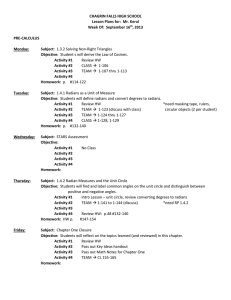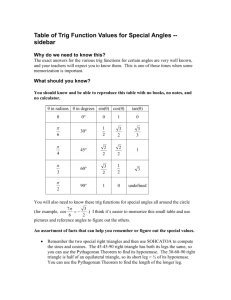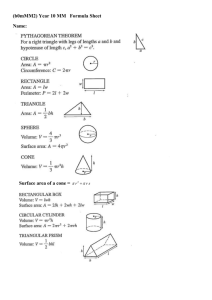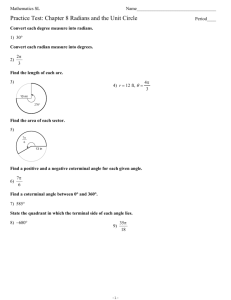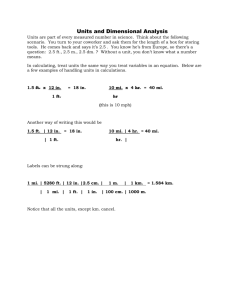Background Knowledge – The Unit Circle, Trigonometric Ratios and
advertisement
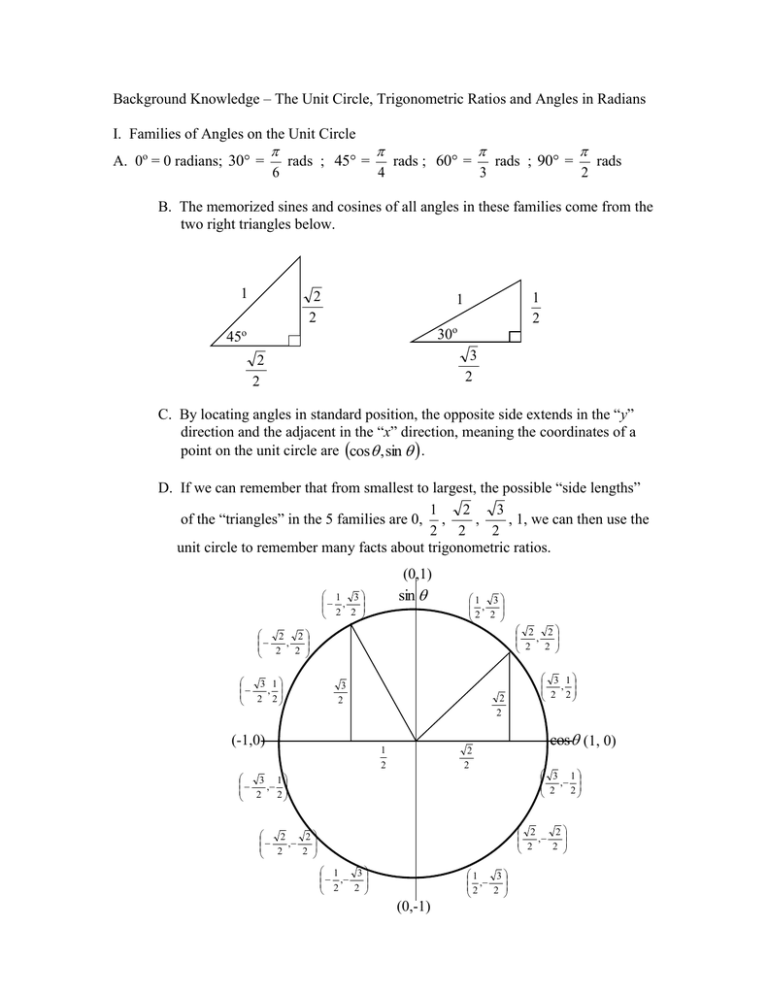
Background Knowledge – The Unit Circle, Trigonometric Ratios and Angles in Radians I. Families of Angles on the Unit Circle A. 0o = 0 radians; 30 = rads ; 45 = rads ; 60 = rads ; 90 = rads 6 4 3 2 B. The memorized sines and cosines of all angles in these families come from the two right triangles below. 1 2 2 1 2 1 30o 45o 3 2 2 2 C. By locating angles in standard position, the opposite side extends in the “y” direction and the adjacent in the “x” direction, meaning the coordinates of a point on the unit circle are cos , sin . D. If we can remember that from smallest to largest, the possible “side lengths” 2 3 1 of the “triangles” in the 5 families are 0, , , , 1, we can then use the 2 2 2 unit circle to remember many facts about trigonometric ratios. (0,1) sin 1 3 , 2 2 1 3 , 2 2 2 2 2 , 2 3 1 2 ,2 3 2 (-1,0) 2 2 1 2 2 2 3 1 2 , 2 2 2 2 , 2 3 1 2 ,2 cos (1, 0) 3 1 2 , 2 2 2 2 , 2 2 2 2 , 2 1 3 , 2 2 1 3 , 2 2 (0,-1) II. The Other 4 Trigonometric Functions A. If the unit circle and an understanding of the families of angles let us evaluate 2 5 , evaluating tangent, trigonometric ratios like cos the answer is 2 4 cotangent, secant and cosecant require us to practice and memorize a few calculations involving the numbers from the unit circle. 1. tan opposite sin adjacent cos 2. sec hypotenuse 1 adjacent cos 3. cot adjacent cos opposite sin 4. csc hypotenuse 1 opposite sin All of the calculations you’ll need are listed below. The best idea is to aspire to eventually be able to know the answer once you see the original fraction. To get to that point, you might need to do the calculations a few times for yourself. 1 undefined 0 1 2 3 2 3 = 3 1 1 2 =2 2 2 2 2 =1 1 2 2 = 3 2 1 2 1 2 3 2 = 3 = 2 3 3 1 =1 1 0 0 1 III. Positive and Negative Angles and Converting to Radians or Degrees A. Positive angles start at the positive x axis and rotate counterclockwise. B. Negative angles start at the positive x axis and rotate clockwise. C. When you convert angles, the result should match in size and direction. 1. You should use families of angles whenever possible, but might have to rely on a conversion factor if the angle doesn’t have a memorized reference angle. Ex: Convert 765o to radians. Think: 765 – 720 = 45. So it is 2 full rotations plus a 4 + 17 = 4 4 4 radians have a lot in common, because they are co4 terminal. They have the same trig. functions, the same reference angle and are in the same quadrant. However, 765o radians. 4 765o and 11 to degrees. 15 Think: 180o and radians are equivalent, so multiplying by 180 or just changes units of measure. 180 Ex: Convert 12o 11 radians 180 11 radians 180 = = -132o 15 radians 15 radians
